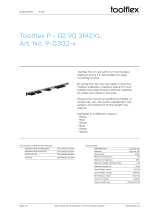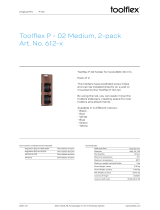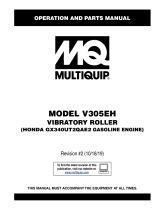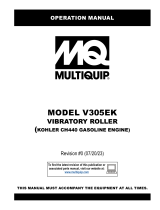Page is loading ...

DYNAPAC
CC102/102C, CC122/122C
CC132, CC142/142C
Box 504, SE-371 23 Karlskrona, Sweden
Phone: +46 455 30 60 00, Fax: +46 455 30 60 30
www.dynapac.com
O102EN3
OPERATION

19
ILF015WO1

Reservation for changes.
Printed in Sweden.
The CC 102/122 and CC 132 are specially designed for repair work on asphalt compounds, but
can also be used for paving small streets, sidewalks and bicycle trails. They are often used as a
complement to bigger rollers for compacting cross-joints and restricted spaces.
The CC 102C and CC 122C are small, light combo rollers that are used for compacting thin layers
and soft asphalt compounds.
The CC 142 is a typical ”town roller” for compacting asphalt compounds on streets, parking lots
and industrial sites. The capacity for this type of work is adequate for following a smaller-size
surface finisher.
The CC 142C is also intended for minor paving jobs on low-traffic asphalt areas where a level and
attractive surface structure is desired. Typical workplaces—in addition to sidewalks and bicycle
trails—are therefore parks, golf courses and sports fields.
Vibratory roller
CC102/102C, CC122/122C
CC132, CC142/142C
KEEP THIS MANUAL
AVAILABLE FOR
FUTURE USE
Operation
O102EN3, December 2001
Diesel engine:
CC 102/C/122/C/132 Deutz F2L 1011F, Isuzu 3 LD1PW-05
CC 132/142/C Deutz F3L 1011F
These instructions apply from:
CC 102/C/122/C
Deutz PIN (S/N) *60110102*
Isuzu (-II) PIN (S/N) *60220102*
CC 132 PIN (S/N) *60230912*
CC 142/C
Deutz PIN (S/N) *60210142*

2
CC 102/C/122/C/132/142/C O102EN3
Safety instructions—Personal safety.
Special caution—Machine or component damage.
Each operator of the roller must study the
safety manual that accompanies each machine.
Always follow the safety rules and do not
remove the manual from the roller.
This manual contains instructions for operation and use of
the roller. For care and maintenance information, see the
MAINTENANCE, CC 102/C/122/C/132/142/C manual.
Remember that when you start and drive a
cold machine, the hydraulic fluid is cold and
the braking distance will be longer than normal
until the machine reaches normal working
temperature.
CONTENTS
WARNING SYMBOLS
GENERAL
SAFETY MANUAL
Page
Safety instructions (Also read the safety manual) ...........3
Safety when driving......................................................4, 5
Safety decals, location and description........................6, 7
Machine and engine plates...............................................8
Instruments and controls..................................................9
Instruments and controls, functional description ......10, 11
Instruments and controls in cab .....................................12
Before starting...........................................................13-15
Starting ...........................................................................16
Operation .......................................................................17
Operation/Vibration ........................................................18
Braking .....................................................................19, 20
Parking...........................................................................21
Instructions for lifting ......................................................22
Instructions for towing ..............................................23, 24
Towing/salvaging ...........................................................25
Transportation ................................................................26
Operating instructions – Summary.................................27
CALIFORNIA
Proposition 65 Warning
Diesel engine exhaust and some of
its constituents are known to the
State of California to cause cancer,
birth defects, and other reproductive
harm.

3
CC 102/C/122/C/132/142/C O102EN3
1. The operator must be familiar with the contents of the OPERATION
MANUAL before starting the roller.
2. Make sure that all instructions in the MAINTENANCE MANUAL are
followed.
3. Only trained and/or experienced operators are allowed to drive the
roller. Passengers are not allowed on the roller. Remain seated during
all operation.
4. Never use the roller if it is in need of adjustment or repairs.
5. Board and leave the roller only when it is stationary. Use the grips and
railings that are provided. A ”three-point grip” is recommended
whenever you board or leave the machine—both feet and one hand, or
one foot and both hands in contact with the machine.
6. Always use the Roll Over Protective Structure (ROPS) when the
machine is used on risky ground.
7. Drive slowly in sharp bends.
8. Avoid driving at an angle on slopes; drive straight up or down.
9. When driving close to unsafe edges or holes, make sure that at least two
thirds of the drum width is firmly on material that has already been
compacted.
10. Make sure that there are no obstacles in the direction of travel, on the
ground or overhead.
11. Drive extra carefully on uneven ground.
12. Use the safety equipment provided. The seat belt must be worn on
machines fitted with ROPS.
13. Keep the roller clean. Clean dirt and grease from the operator’s platform
without delay. Keep all signs and decals clean and clearly legible.
14. Safety measures before refueling:
– Stop the engine.
– Don’t smoke.
– No naked flame in the vicinity.
– Ground the nozzle of the filling device against the tank to prevent
sparks.
15. Before repairs or service:
– Place chocks against the drums/wheels and against the strike-off
blade.
– Lock the articulation if necessary.
16. Hearing protectors are recommended if the noise level is higher than 85
db(A). The noise level will vary depending on the surface being worked
on by the machine.
17. Make no changes or modifications on the roller that could affect safety.
Changes may only be made following written consent by Dynapac.
18. Do not use the roller until the hydraulic fluid has reached its normal
working temperature. Braking distance can be longer than usual if the
fluid is cold. See starting instructions in the OPERATION MANUAL.
SAFETY INSTRUCTIONS (Also read the safety manual)

4
CC 102/C/122/C/132/142/C O102EN3
ROPS is always recommended when dri-
ving on slopes or insecure ground.
Where possible, avoid all driving across
slopes. Drive up and down on sloping
ground.
The tipping angle given here applies to smooth, hard
ground and a stationary machine. Steering angle zero,
vibration switched OFF and all tanks full. Remember
that loose ground, steering of the machine, vibration
switched ON, driving speed and an increase in height
of the center of gravity (for example, with accessories)
may cause the machine to topple even on a smaller
slope than that specified here.
Driving near an edge
When driving near an edge, at least two thirds of the
drum width must be on solid ground.
Remember that the machine’s center of
gravity is displaced outwards when stee-
ring to one side. For example, it moves to
the right when steering to the left.
Fig. 1 Position of drum when driving near
an edge
At least
2/3
Slopes
Max. 20°
or 36%
Fig. 2 Tipping angle on side slopes
SAFETY WHEN DRIVING
To leave the cab in an emergency, release
the hammer located on the rear right post
and break the rear window.

5
CC 102/C/122/C/132/142/C O102EN3
SAFETY WHEN DRIVING
Fig. 3 Operator’s station
1. ROPS
2. Seat belt
Sitting position
Always remain seated in the operator’s seat for all
driving. If the operator rises from his seat the horn will
sound, or on some versions the brakes will be applied.
Always fasten the seat belt if the machine
is equipped with one. Should the machine
turn over there is a serious risk that the
operator will fall out with the machine on
top of him if he has not fastened the seat
belt.
The seat belt is standard equipment on rollers equipped
with a Roll Over Protective Structure (ROPS) (1) or a
cab.
1
2

6
CC 102/C/122/C/132/142/C O102EN3
SAFETY DECALS, LOCATION AND DESCRIPTION
4 13 5 2
8 12 7 1 12 6 3
8 12 9 1 6 12 3
11 5 2 4 10
(The figure shows the Combo version)

7
CC 102/C/122/C/132/142/C O102EN3
SAFETY DECALS, LOCATION AND DESCRIPTION
Crush zone, articulation/
drum. Maintain a safe
distance from the crush
zone.
Warning—very hot surfaces
in the engine compartment.
Do not touch.
Warning—rotating engine
components. Keep your
hands at a safe distance from
the danger zone.
The operator is urgently
requested to read the safety
manual, and the operation
and maintenance
instructions, before using
the machine.
1.
2.
5.
4.
903424
903459
903423
903422
The articulation joint must be
locked while lifting. Read the
instruction manual.
3.
Lifting point
Diesel fuel
8.
7.
357587
991658
908229
13.
Mass Kg
904870
Hoisting plate
Hydraulic
fluid
Biological
hydraulic
fluid
272372 904601
9.
Alt. 1 Alt. 2
Battery
disconnecter
11.
904835
Securing
point
12.
382751
10.
Handbook
compartment
903425
6.

8
CC 102/C/122/C/132/142/C O102EN3
Machine plate
Fig. 6 Engine (Deutz)
1. Type plates
ISUZU:
A decal showing the engine serial number is affixed to
the oil sump below the fuel and oil filter. There is also a
decal on top of the cylinder head cover showing the
model designation. See also the engine manual.
Engine plate
Fig. 4 Left step
1. Machine plate
Serial number on frame
Fig. 5 Front frame
1. Serial number
1
1
MACHINE AND ENGINE PLATES
The machine type plate (1) is affixed on the front left
side of the frame, by the steering joint. The plate shows
the manufacturer’s name and address, type of
machine, PIN (product identification number/serial
number), weight in working order, engine power and
year of manufacture. (Only the manufacturer’s name
and address, PIN and type of machine will be noted if
the machine is delivered outside the EU.)
Please specify the roller PIN when ordering spares.
The machine’s PIN (1) is punched on the right edge of
the forward frame.
The machine type plate (1) is affixed on top of the
engine. The plate indicates the type of engine, serial
number and engine data. Please specify the engine
serial number when ordering spares. See also the
engine manual.
IMPORTANT ENGINE INFORMATION
DEUTZ
®
ENGINE FAMILY POWER VALVE LASH INJ. TIMING
MODEL RPM ENGINE DISPLACEMENT INJ. RATE
THIS ENGINE CONFORMS TO YYYY MODEL YEAR US EPA /
REGULATIONS FOR LARGE NONROAD COMPRESSION IGNITIONENGINES
SERIAL NO REM
THIS ENGINE IS CERTIFIED TO OPERATE ON DIESEL FUEL
DEUTZ
®
DEUTZ AG MADE IN GERMANY
Mot.-Typ
kW (G)
kW (W)
E
Code Mot.-Nr.
kW (S) kW (S)
m
°C
kW
kW
EP K
1

9
CC 102/C/122/C/132/142/C O102EN3
Fig. 7 Operator’s station
789101112
13
14
16
15
6
5
4
3
2
1
17
22
19
20
21
13.Driving lights
14.Sprinkler rubber wheel (Combo)/
vibration front/rear drum
15.Hazard flashers
16.Direction indicator
17.Safety and instruction manuals
18.Fuse boxes
19.Rev control
20.Vibration ON/OFF
21.Forward/reverse lever
22.Fuel gauge
23.Seat switch
1.Horn
2.Ignition switch
3.Manual/Automatic sprinkler
4.Starter button
5.Manual/Automatic vibration
6.Reserve/parking brake
7.Instrument protection
8.Warning lamp, charging
9.Brake warning lamp
10.Warning lamp, oil pressure/
engine temp.
11.Working lights
12.Hazard beacon
18
=Optional
23
INSTRUMENTS AND CONTROLS

10
CC 102/C/122/C/132/142/C O102EN3
Items Designation Symbol Function
in fig. 7
1 Horn, switch Press to sound the horn.
2 Main power switch In position O the electric circuit is broken.
In position I all electric switches and lamps
except the starter motor circuit are powered.
3 Sprinkler system, drum Regulates the flow of water to the drum.
MAN mode gives continuous watering.
Watering is OFF in 0 mode.
The AUT mode gives automatic switching of
watering ON/OFF while driving forward and
reverse.
4 Starter contact Press to run the starter motor.
5 Vibration switch Middle position=Vibration switched OFF.
(Optional) Left position= Vibration on both drums (not C)
Right position=Vibration on one drum.
6 Reserve brake//Parking brake Press to activate the reserve brake. Press
when the machine is stationary to activate the
parking brake.
Pull out to release both brakes.
7 Instrument protection Lower over the instrument plate as protection
against weather and sabotage.
8 Warning lamp, If the lamp lights while the engine is running,
battery charging the alternator is not charging.
Stop the engine and locate the fault.
9 Brake warning lamp The lamp lights when the parking or reserve
brake knob is pushed in and the brakes are
applied.
10 Warning lamp, oil pressure, The warning lamp lights if lubricating oil
or excessive temperature pressure is too low. Stop the engine andof
engine oil. remedy the cause. See engine manual.
11 Working lights backwards, Turn right to switch on the working lights.
switch (Optional)
12 Hazard beacon, Turn right to switch on the hazard beacon.
switch (optional)
13 Working lights forward, Turn right to the first position to switch on the
switch (Optional) parking lights and to the second position to
switch on the forward working lights.
14 Sprinkler system, Regulates the flow of fluid to the tires
tires (Combo) Turn left=continual operation.
Turn right=intermittent operation.
MAN
O
AUTO
STOP
INSTRUMENTS AND CONTROLS, FUNCTIONAL DESCRIPTION

11
CC 102/C/122/C/132/142/C O102EN3
15 Hazard flasher, Turn right to switch on the flashing
switch (optional) warning lights.
16 Direction indicator, Turn left to switch on the left direction
switch (optional) indicator. The flashing indicator is OFF in the
middle position.
17 Pocket for manuals Pull up and open the top of the compartment
for access to handbooks.
18 Fuse box Contains fuses for the electrical system.
(on front of steering column) See under the heading ”Electrical system” for
a description of the functions of the fuses.
19 Rev control, The right position gives engine idling revs.
diesel engine The left position gives full revs.
20 Vibration ON/OFF, Press once and release to switch vibration
switch ON, press again to switch vibration OFF. The
above applies only when switch 5 is in the left
position.
21 Forward/Reverse lever The lever must be in neutral to enable the
engine to start; the engine will not start if the
forward/reverse lever is in any other position.
The forward/reverse lever controls the driving
direction and speed of the roller. Move the
lever forward to drive the roller forward, etc.
The speed of the roller is proportional to the
distance of the lever from the neutral position.
The further from neutral the higher the speed.
22 Warning lamp, When the lamp lights, there is only sufficient
low fuel level (optional) fuel left for a short distance. Refuel as soon
as possible.
23 Seat switch Remain seated during all operation. If the
operator rises from his seat the horn will
sound, or the brakes will be applied.
INSTRUMENTS AND CONTROLS, FUNCTIONAL DESCRIPTION

12
CC 102/C/122/C/132/142/C O102EN3
1 2 3 4 5 6 7 8 9 10 11 12
Fig. 8 Cab
1. Heater control
2. Fuse boxes
3. Working lights
4. Front wiper
5. Rear wiper
6. Front washer
7. Rear washer
8. Working lights
9. Hazard beacon
10. Fan
11. Interior lighting
12. Radio = Optional equipment
Items Designation Symbol Function
in fig. 8
1 Heater control Regulates heat in the cab.
Turn right to increase heat, turn left to reduce.
2 Fuse boxes (cab) Contains fuses for the electrical system.
See under the heading ”Electrical system” for
a description of the functions of the fuses.
3 Working lights,
front, switch Press to switch on the front working lights.
4 Front wiper switch Press to operate the front windshield wiper.
5 Rear wiper switch Press to operate the rear windshield wiper.
6 Front washer switch Press to wash the front window.
7 Rear washer switch Press to wash the rear window.
8 Rear working lights switch Press to switch on the rear working lights.
9 Hazard beacon Press to switch on the hazard beacon.
10 Fan switch Press to operate the fan.
11 Interior lighting switch Push forward to switch on the interior lighting.
12 Radio
INSTRUMENTS AND CONTROLS IN CAB

13
CC 102/C/122/C/132/142/C O102EN3
2
1
Fig. 9 Left side of engine
1. Battery disconnecter
2. Hourmeter
Battery disconnecter
– Switching on
1
2
Sprinkler system/tires
Fig. 11 Emulsion tank
1. Filler cap
2. Sprinkler pipe
3. Fastening screws
1
2
Sprinkler system/drum
Fig. 10 Water tank
1. Filler cap
2. Sprinkler pipe
Fill the rear emulsion tank with water and possibly
cutting oil. Mixing 2–4% cutting oil (Fileum) in the
sprinkler water for the tires can prevent fastening.
Make sure that the sprinkler pipe (2) is in position to
give satisfactory spreading of water mist over the tires.
Slacken the fastening screws (3) of the pipe clip to
adjust the pipe.
Inspect the tire tread now and then to detect asphalt
compound that has fastened. This is likely until the tires
are sufficiently warm.
Fill the front water tank, and check that the sprinkler
pipe (2) is in position to distribute water mist over the
whole surface of the drum. Loosen the fastening
screws (3) of the pipe clips to adjust the pipe; see
figure below.
3
BEFORE STARTING
Remember to perform daily service. See the operation
manual.
The battery disconnecter is located in the engine
compartment. Turn the key (1) to the ON position. The
entire roller is now powered.
Item (2) is the engine hour meter. The number of hours
is counted as long as the engine is running.
The engine hood must be unlocked during
operation, so the battery power can be
disconnected quickly if necessary.

14
CC 102/C/122/C/132/142/C O102EN3
Fig. 13 Comfort seat (optional)
1. Backrest slope
2. Length adjustment
3. Weight adjustment
4. Transverse adjustment (optional)
2
3
4
1
Operator’s seat – Setting
1. Set the operator’s seat in a comfortable position and
so that the controls are easily accessible.
2. The seat has the following adjustment capabilities:
– Length adjustment (1)
– Backrest slope (2)
– Weight adjustment (3)
Always ensure that the seat is secure
before beginning operation.
1. Set the operator’s seat in a comfortable position and
so that the controls are easily accessible.
2. The seat has the following adjustment facilities:
– Backrest slope (1)
– Length adjustment (2)
– Weight adjustment (3)
– Crosswise (4)
Comfort – Adjusting
BEFORE STARTING
1
3
2
Fig. 12 Operator’s seat
1. Lever—length adjustment
2. Lever—backrest slope
3. Lever—weight adjustment

15
CC 102/C/122/C/132/142/C O102EN3
6 9
8 9 10 14
3
2
Instruments and lamps
– Check
Fig. 14 Instrument panel
2. Ignition switch
3. Sprinkler switch (drum)
8,9,10. Warning lamps
14. Sprinkler switch (rubber tires)
Turn the ignition switch (2) to the right position.
Check that the warning lamps 8, 9 and 10 light.
Turn the switches (3) and (14) for sprinklers to opera-
ting mode and make sure that the system is working.
Fig. 15 Instrument panel
6. Reserve/parking brake knob
9. Brake warning lamp
Parking brake – Control
BEFORE STARTING
Make sure that the reserve/parking brake
knob (6) is pushed in. If the parking brake
is not applied, the roller may start to roll
when you start the engine on sloping
ground.
IInterlock (Optional)
The engine switches off 4 seconds after the operator
rises from the seat. This will occur regardless of
whether the forward/reverse lever is in neutral or drive
mode. The engine will not stop if the parking brake is
activated.
Always replace the seat belt (1) with a new
one if it is worn or has been subjected to a
heavy load.
Check that rubber elements (3) on the platform
are intact. Worn elements will impair comfort.
Make sure that anti-slip (4) on the platform
is in good condition; replace with new anti-
slip if friction is poor.
If the machine is fitted with a cab, make
sure that the door is closed when in mo-
tion.
Always fasten the seat belt (1) that is provided if a Roll
Over Protective Structure (ROPS) or a cab is fitted on
the roller, and wear a protective helmet.
Operator’s station
1
Fig. 16 Operator’s station
1. Seat belt
2. Safety railing
3. Rubber element
4. Anti-slip
2
3
4

16
CC 102/C/122/C/132/142/C O102EN3
Starting the engine
Set the vibration switch (5) for manual/automatic vibra-
tion to the O mode.
Set the rev control (19) to idling mode. (On certain
versions, the control is located on the right side of the
instrument column.)
Turn the ignition switch (2) to the right to position I.
Press the starter switch (4). Release the starter switch
as soon as the engine fires.
Fig. 18 Instrument column
2. Ignition switch
4. Starter switch
5. Vibration switch
6. Reserve/parking brake knob
8. Charging lamp
9. Brake warning lamp
10. Oil pressure lamp
19. Rev control
659
4
2
Fig. 17 Forward/reverse lever
21
19
Set the forward/reverse lever (21) in neutral. The
engine cannot be started if the lever is in any other
position.
On certain versions, the F/R lever is located at the side
of the instrument panel, but the function is the same.
STARTING
Do not run the starter motor too long;
preferably wait a minute or so if the engine
does not start.
Warm up the engine at idling speed for a few minutes,
longer if the ambient temperature is below +10°C
(50°F).
Check while warming up that the warning lamps for oil
pressure (10) and charging (8) are out. The warning
lamp for the parking brake (9) should still light.
Remember that when you start and drive a
cold machine, the hydraulic fluid is cold
and the braking distance will be longer
than normal until the machine reaches
normal working temperature.
Make sure that ventilation (extraction) is
adequate if the engine is run indoors. Risk
of carbon monoxide poisoning.
810

17
CC 102/C/122/C/132/142/C O102EN3
19
6914
Fig. 19 Instrument column
3. Sprinkler switch (drum)
6. Reserve/parking brake knob
9. Brake warning lamp
14. Sprinkler switch (rubber tires)
19. Rev control
3
Driving the roller
21
Fig. 20 Forward/reverse lever
OPERATION
Under no circumstances may the machine
be operated from the outside. The operator
must remain seated inside the machine
during all operation.
Turn the rev control (19) and latch it in its working
mode.
Check that the steering is working by turning the
steering wheel once to the right and once to the left,
while the roller is stationary.
When compacting asphalt, remember to turn on the
watering unit (3), on combo rollers also (14).
Make sure that the area in front of and
behind the roller is clear.
Pull up the reserve/parking brake knob (6)
and check that the warning lamp for the
parking brake is out. When starting the
roller on a slope, be prepared that it may
begin to roll.
Combo machines only:
Inspect the tire tread now and then to detect
asphalt compound that has fastened, this is
likely until the tires are sufficiently warm.
Mixing 2–4% cutting oil in the sprinkler water
for the tires can prevent fastening.
Carefully move the forward/reverse lever (21) in the
desired direction of travel. Speed increases as the
lever is moved farther from the neutral position.
Speed must always be regulated with the
forward/reverse lever and never by changing
the engine speed.
Test the reserve brake by pressing the
reserve/parking brake knob (6) while the
roller is running slowly forward.

18
CC 102/C/122/C/132/142/C O102EN3
Vibration is engaged and disengaged with the
changeover switch (20) on the forward/reverse lever.
Always switch off vibration before the roller comes to a
complete standstill.
Vibration should not be allowed when the roller
is stationary; this may damage the surface
and the machine.
Manual/Automatic vibration
5
Fig. 21
5. Vibration switch
Fig. 23 Instrument panel
14. Vibration front/rear drum
20
Fig. 22 Forward/reverse lever
20. Vibration ON/OFF
Vibration on one drum (Optional)
OPERATION/VIBRATION
Select manual or automatic switching ON/OFF with
switch (5).
In manual mode, the operator must activate vibration
via the switch (20) on the forward/reverse lever.
In automatic mode, the vibration is activated when the
pre-set speed is reached.
Even switching off is automatic when the lowest speed
is reached.
Manual vibration—Switching on
14
The selector switch (14) is used to choose vibration on
the rear drum only or on two drums, ON/OFF.
In vibration ON mode, the operator must activate vibra-
tion via the switch (20) on the forward/reverse lever.
In left position, vibration is applied to both drums.
In right position, vibration is activated on the rear drum.
/




